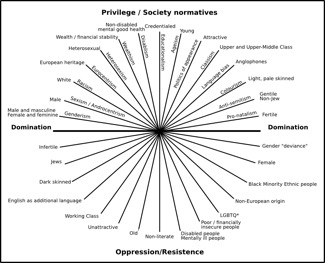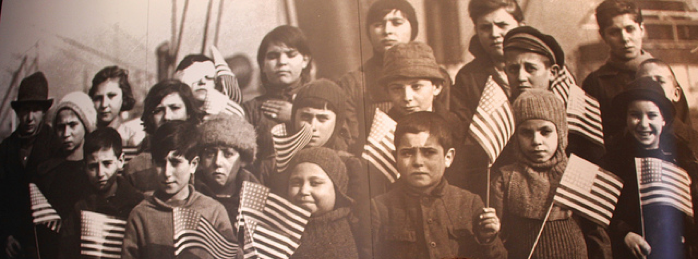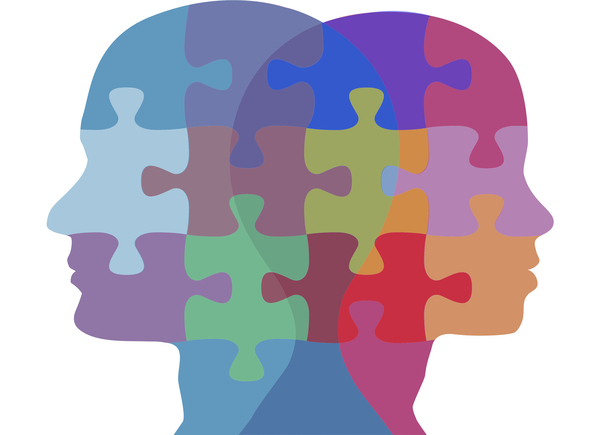9.1 Assimilation

The Mortar of Assimilation and the One Element that Won’t Mix
Cartoon from PUCK June 26, 1889 – public domain.
Classic assimilation theory or straight-line assimilation theory can be dated back to the 1920’s originating from the Chicago School of Sociology (Park, Burgess, & McKenzie, 1925; Waters, Van, Kasinitz, & Mollenkopf, 2010). This early assimilation model set forth by Park (1928) described how immigrants followed a straight line of convergence in adopting “the culture of the native society” (Scholten, 2011). In many ways assimilation was synonymous with ‘Americanization’ and interpreted as ‘becoming more American’ or conforming to norms of the dominant Euro-American culture (Kazal, 1995). Assimilation theory posited that immigrant assimilation was a necessary condition for preserving social cohesion and thus emphasized a one-sided, mono-directional process of immigrant enculturation leading to upward social mobility (Warner & Srole 1945). Assimilation ideas have been criticized for lacking the ability to differentiate the process of resettlement for diverse groups of immigrants; they fail to consider interacting contextual factors (van Tubergen, 2006).
Segmented assimilation theory emerged in the 1990’s as an alternative to classical assimilation theories (Portes & Zhou, 1993; Waters et al., 2010). Segmented assimilation theory posits that depending on immigrants’ socioeconomic statuses, they may follow different trajectories. Trajectories could also vary based on other social factors such as human capital and family structure (Xie & Greenman, 2010). This new formulation accounted for starkly different trajectories of assimilation outcomes between generations and uniquely attended to familial effects on assimilation. The term often employed when one group is at a greater advantage and is able to make shifts more readily is segmented assimilation (Boyd, 2002).
Later, Alba and Nee (2003) formulated a new version of assimilation, borrowing from earlier understandings yet rejecting the prescriptive assertions that later generations must adopt Americanized norms (Waters et al., 2010). Within their conceptualization, assimilation is the natural but unanticipated consequence of people pursuing such practical goals of getting a good education, a good job, moving to a good neighborhood and acquiring good friends (Alba & Nee, 2003).
Numerous studies have utilized assimilation theories to guide their inquiry with diverse foci like adolescent educational outcomes, college enrollment, self-esteem, depression and psychological well-being, substance use, language fluency, parental involvement in school, and intermarriage among other things (Waters & Jimenez, 2005; Rumbaut, 1994). Despite such widespread use of assimilation, some scholars have noted that the theory may not adequately explain immigrants’ diverse and dynamic experiences (Glazer, 1993) and some note that other theories such as models of self-esteem or social identity may be added to assimilation to bolster its value (Bernal, 1993; Phinney, 1991).
A further critique is that a push for assimilation may mask an underlying sentiment that immigrants and refugees are unwelcome guests who have to compete for scarce resources (Danso, 1999; Danso & Grant, 2000). These sentiments can impact the reception and adaptation experiences of immigrant populations in the receiving country (Esses, Dovidio, Jackson, & Armstrong, 2001). Extreme nationalism and a sense of fear may encourage ideals of conformity that defines ‘successful integration’ or ‘successful resettlement’ as full adoption of the receiving country’s ways and beliefs while giving up old cultures and traditions. There is little or no support for the maintenance of cultural or linguistic differences, and groups’ rights may be violated. This belief can lead to misunderstandings when new United States residents speak, act, and believe differently than the dominant culture. It can result in an unwelcoming environment and prevent the development and offering of culturally and linguistically appropriate services for immigrant and refugee families, erecting barriers to their opportunity to adapt and thrive in their new homes. Assimilation may implicitly assume that some cultures and traits are inferior to the dominant White-European culture of the receiving nation and therefore should be abandoned for ways more sanctioned by that privileged group.
Acculturation and Adaptation
Later Milton Gordon’s newer multidimensional formulation of assimilation theory provided that ‘acculturation,’ which refers to one’s adoption of the majority’s cultural patterns, happens first and inevitably (1964). Contemporary acculturation models embrace some of the previous ideas of assimilation but can be less one-dimensional (Berry, 1990). At times, the terms assimilation and acculturation have been used interchangeably. John Berry employed the concept of acculturation and identified 4 modes: integration (where one accepts one’s old culture and accepts one’s new culture), assimilation (where one rejects one’s old culture and accepts one’s new culture), separation (where one accepts one’s old culture and rejects one’s new culture), and marginalization (where one rejects one’s old culture and also rejects one’s new culture) (Berry, 1990). This understanding of acculturation proposes that immigrants employ one of these four strategies by asking how it may benefit them to maintain their identity and/or maintain relationships with the dominant group, and does not assume that there is a typical one-dimensional trajectory they would follow.
While assimilation is applied to the post-migration experience generally, acculturation refers to the psychological or intrapersonal processes that immigrants experience (Berry, 1997). Hence, the concept of acculturative stress –linked to psychological models of stress (Lazarus & Folkman, 1984) arose to describe how incompatible behaviors, values, or patterns create difficulties for the acculturating individual (Berry, Kim, Minde, & Mok, 1987). Adaptation has been used in recent years to refer to internal and external psychological outcomes of acculturating individuals in their new context, such as a clear sense of personal identity, personal satisfaction in one’s cultural context, and an ability to cope with daily problems (Berry, 1997).
Much of the discourse concerning adaptation has focused on the socio-economic adaptation of immigrants as measured by English language proficiency, education, occupation, and income. When culture is included, the emphasis is typically on concepts of ethnic intermarriage and language proficiency (van Tubergen, 2006). Much less attention has been paid to how immigrants form attachments to their new society, subjective conceptions of ‘success’ in the new country, or to the factors that lead some immigrants to retain distinct characteristics and identities but adopt to new ways of being. Some have gone further to identify three types of adaptation: psychological, sociocultural, and economic (Berry, 1997).
Videos
Paul Orieny, Sr. Clinical Advisor for Mental Health, The Center for Victims of Torture (CVT), discusses the challenges of coping with the magnitude of change encountered during resettlement (0:00-4:28).
True Thao, MSW, LICSW discusses cultural change and adaptations experienced by immigrants and refugees (1:43-2:40)
Multiculturalism and Pluralism
Theories of assimilation, acculturation, and adaptation are all focused on the immigrant. This is not to say that these theories have not included the receiving society or the dominant group’s influence on the immigrant. However, a different way to conceptualize the post-migration experience may be by exploring how any society can support multicultural individuals both, United States-born and foreign-born, and how adjustments and accommodations are made by both the receiving culture and the immigrant culture to aid resettlement.
Multiculturalism and pluralism are often understood as the opposite of assimilation (Scholten, 2011), emphasizing a culturally open and neutral understanding of society. These ideas purport that diverse people need freedom to determine their method of resettlement and the degree to which they will integrate. A nation that embraces a multicultural view may promote the preservation of diverse ethnic identities, provide political representation, and protect rights of minority populations (Alba, 1999; Alexander, 2001). There are those, especially more liberally minded groups that support the idea that immigrant groups should not be judged according to their religion, skin color, ability or willingness to assimilate, language, or what is deemed culturally useful. Because multiculturalism acknowledges differences and responds to inequality in a society, critics charge that it is a form of ethnic or “racial particularism” that goes against the solidarity on which the United States democracy stands (Alexander, 2001, p. 238). Behind every policy are assumptions that implicitly or explicitly support a vast theoretical and ideological continuum. With the ebb and flow of immigration throughout the history of this country, some of these ideological positions have shifted, and also residuals of traditional nationalistic ideals remain.
Intersectionality Theory
The lessons learned from earlier conceptualizations of immigrant resettlement are 1) that an accurate understanding of resettlement is flexible, dynamic, and heterogeneous; 2) that resettlement itself is a synergistic process between the newcomer and the receiving society; and 3) that ultimately the knowledge of how resettlement is experienced, is best understood from the standpoint of an immigrant. Thus in many ways, the discourse about immigrant experiences has shifted from an emphasis on group processes to individual processes. Contemporary scholars are beginning to explore the theory of intersectionality as a lens to understand immigrant identities and adaptation to receiving countries (Cole, 2009; Shields, 2008). Intersectionality theory allows for an understanding of the complex intersections of an individual’s identities shaped by the groups to which an individual belongs or to which s/he is perceived to belong, along with the interacting effects of an individual and the different contexts they are in. Intersectionality theory does not claim to be apolitical; it posits that an accurate understanding of the experiences of marginalization requires knowledge of broad historical, socio-political, cultural, and legal contexts. While theories of assimilation and acculturation tend to endorse integration – a stage in which an immigrant has successfully integrated their culture or origin and new culture (Sakamoto, 2007), intersectionality theory proposes that structural issues such as discrimination, migration policy, and disparity in accessibility of resources based on language or nationality, affect an immigrant’s ability or desire to integrate.
Intersectionality is a feminist sociological theory developed by Kimberlé Crenshaw (1989), which posits that one, cannot truly arrive at an adequate understanding of a marginalized experience by merely adding the categories such as gender plus race, plus class, etc. Rather these identity categories must be examined as interdependent modes of oppression structures that are interactive, and mutually reinforcing.
Intersectionality rests on three premises. First, it is believed that people live in a society that has multiple systems of social stratification. They are afforded resources and privileges depending on one’s location in this hierarchy (Berg, 2010). Social stratification can best be understood by accepting the premise that there are forms of social division in society that are based on identities or attributes, such as gender, race, nativity, class, etc. Within society, some of these social divisions are more valued than others, thus creating a hierarchy, or in cruder terms, a pecking order. These divisions and hierarchy are arbitrary in that they are socially constructed and have no essential meaning but have been established by those in power and maintained by society historically. Those deemed higher on the hierarchy and having more ‘status’ are provided with power and privileges and those deemed lower on the hierarchy are not (Anthias, 2001). Much research has been conducted on gender inequalities (Pollert 1996, Gottfried, 2000), ethnic inequalities (Modood et al., 1997) and class inequalities (Anthias & Yuval Davis, 2005; Bradley, 1996), providing evidence for the social constraints in the shape of sexism, racism, classism, etc.
The second premise on which intersectionality rests is that social stratification systems are interlocked. Every individual may hold different positions in different systems of stratification at the same time; there is not only variation among groups of people but within groups of people (Weber, 1998). The implications of this premise for immigrant populations are profound; individuals within immigrant communities may not have the same experiences adjusting to a new society given the varied positions they hold within different contexts based on their identities and attributes.
Within intersectionality theory, an individual has multiple intersecting identities. These identities are informed by group memberships such as gender, class, race, sexuality, ethnicity, ability, religion, nativity, gender identity, and more (Case, 2013). Intersecting identities place an individual at a particular social location. Individuals may have similar experiences with other individuals within one community, such as similar experiences to others of their nation of origin, but their experiences may also be quite different depending on other identities they hold.
For example, an immigrant is not only from Central America and female, but is a Latina woman, two identities that when combined, create her unique experience.
There are pressures to conform to the expectations of each social group to which an individual belongs. Each cultural community has images, expectations, and norms associated with it. These ideas vary by culture and generation because they are constructed for that time, group, and purpose. Conformity to expectations of a social group has both tangible and intangible benefits (Cialdini, 2001), not the least of these is the benefit of affiliation (Cialdini & Trost 1998). There has been much research about conflict and dissonance that can arise from an individual’s pressure to identify with the larger social groups and contexts, and also reaffirm their identity within their family’s cultural group or the culture of their country of origin (Farver, Narang, & Bhadha, 2002; Phinney, Horenczyk, Liebkind, & Vedder, 2001; Rumbaut, 1994).

Adapted by Natalya D. From Morgan, K. P. (1996). Describing the Emporaro’s New Clothes: Three Myths of Education (In)Equality. In A. Diller (ed). The Gender Question in Education: Theory, Pedagogy & Politics. Boulder, CO: Westview. Image available at: sites.google.com/site/natalyadell/home/intersectionality.
The third premise of intersectionality is that where one is located within this complex social stratification system will consequently influence one’s worldview. This is logical given that each individual has different experiences depending on where they are located within the social stratification system (Demos & Lemelle, 2006). This speaks to one’s positionality – a person’s location across various axes of social group identities which are interrelated, interconnected, and intersecting. One’s position informs one’s unique standpoint. Furthermore, these identities may be external/visible, such as race and gender, or internal/invisible, such as sexuality or nativity, and carry privileges or limit choices depending upon one’s positionality. Thus one’s position and standpoint may be the most suitable way in which to frame and understand the discussion of immigrant resettlement. An example would be how research has indicated that skin color, often a physical feature that indicates identity, affects how an immigrant experiences and adapts to their new society (Telzer & Garcia, 2009; Viruell-Fuentes, 2007).
The concept of intersectionality has been revolutionary in conceptualizing the lived experiences of people existing on the margins of society, a place where immigrants and refugees often find themselves existing. Specifically, intersectionality highlights ways in which “social divisions are constructed and intermeshed with one another in specific historical conditions to contribute to the oppression” of certain groups (Oleson, 2011, p. 134). Many hail the usefulness of intersectionality as a methodological tool that allows researchers to explore the interacting effects of multiple identities (Weldon, 2006). For example, research could examine ways that an immigrant may make decisions based on several important aspects of her/his identity such as race, gender, social class position, religion, and nationality.
This theory has been used to explore immigrants’ economic success, their experience of internalized classism, and their power and access to resources (Ali, Fall, & Hoffman, 2012; Cole, 2009). Intersectionality may be a unifying theory that illuminates the immigrant experience in a way that increases understanding of the role of the larger society, informs the efforts of each community, and provides a framework for policy.

David Fulmer – Picture this! Immigrant Children (at Ellis Island) – CC BY 2.0.


